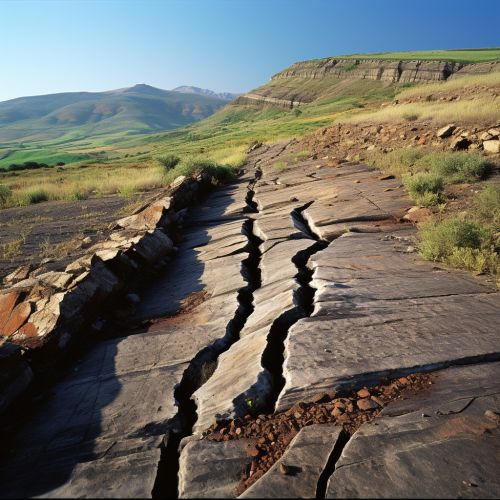Strike-slip fault
Introduction
A strike-slip fault is a type of fault in which two blocks of rock slide past each other horizontally along the direction of the fault plane. This movement is primarily caused by shear stress that exceeds the rock strength, resulting in a displacement. The displacement can be either right-lateral or left-lateral, depending on the movement direction of the blocks.


Types of Strike-slip Faults
There are two main types of strike-slip faults: right-lateral and left-lateral.
Right-lateral Strike-slip Fault
In a right-lateral strike-slip fault, when observed from above or map view, the block on the opposite side of the fault moves to the right. This movement is relative to the observer's position. The San Andreas Fault in California is a well-known example of a right-lateral strike-slip fault.
Left-lateral Strike-slip Fault
Conversely, in a left-lateral strike-slip fault, the block on the opposite side of the fault moves to the left when observed from above or map view. The Dead Sea Transform fault is an example of a left-lateral strike-slip fault.
Geological Implications
Strike-slip faults have significant implications in the field of geology. They play a crucial role in the movement of tectonic plates and can lead to the formation of pull-apart basins, linear valleys, and offset streams.
Tectonic Plate Movement
Strike-slip faults are often associated with the boundaries of tectonic plates. They facilitate the horizontal movement of these plates, contributing to the dynamic nature of the Earth's crust.
Formation of Pull-apart Basins
Pull-apart basins, also known as rheic basins, can form along strike-slip faults due to the extensional forces that occur in areas where the fault path deviates. These basins are often sites of sediment accumulation and can host significant hydrocarbon reserves.
Formation of Linear Valleys and Offset Streams
Linear valleys and offset streams can also form due to the movement along strike-slip faults. These features are often visible indicators of active faulting and can provide valuable information about the history and rate of fault movement.
Seismic Activity
Strike-slip faults are often associated with significant seismic activity. Earthquakes that occur along these faults can be particularly damaging due to the horizontal nature of the ground movement.
Earthquake Generation
The movement of rock blocks along a strike-slip fault can generate earthquakes. The release of accumulated stress along the fault plane leads to seismic waves that cause the ground to shake.
Earthquake Magnitude and Frequency
The magnitude and frequency of earthquakes along strike-slip faults can vary widely. Factors influencing this include the rate of stress accumulation, the strength of the rocks involved, and the geometry of the fault.
